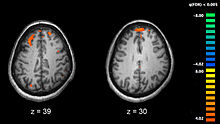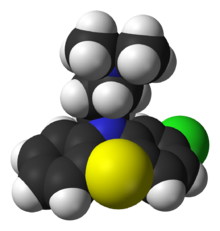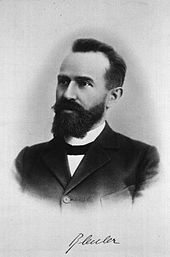
Schizophrenia
Did you know...
Arranging a Wikipedia selection for schools in the developing world without internet was an initiative by SOS Children. Do you want to know about sponsoring? See www.sponsorachild.org.uk
Schizophrenia ( / ˌ s k ɪ t s ɵ ˈ f r ɛ n i ə / or / ˌ s k ɪ t s ɵ ˈ f r iː n i ə /) is a mental disorder characterized by a breakdown of thought processes and by a deficit of typical emotional responses. Common symptoms include auditory hallucinations, paranoid or bizarre delusions, or disorganized speech and thinking, and it is accompanied by significant social or occupational dysfunction. The onset of symptoms typically occurs in young adulthood, with a global lifetime prevalence of about 0.3–0.7%. Diagnosis is based on observed behaviour and the patient's reported experiences.
Genetics, early environment, neurobiology, and psychological and social processes appear to be important contributory factors; some recreational and prescription drugs appear to cause or worsen symptoms. Current research is focused on the role of neurobiology, although no single isolated organic cause has been found. The many possible combinations of symptoms have triggered debate about whether the diagnosis represents a single disorder or a number of discrete syndromes. Despite the etymology of the term from the Greek roots skhizein (σχίζειν, "to split") and phrēn, phren- (φρήν, φρεν-; "mind"), schizophrenia does not imply a "split personality", or "multiple personality disorder" (which is known these days as dissociative identity disorder)—a condition with which it is often confused in public perception. Rather, the term means a "splitting of mental functions", because of the symptomatic presentation of the illness.
The mainstay of treatment is antipsychotic medication, which primarily suppresses dopamine (and sometimes serotonin) receptor activity. Psychotherapy and vocational and social rehabilitation are also important in treatment. In more serious cases—where there is risk to self and others— involuntary hospitalization may be necessary, although hospital stays are now shorter and less frequent than they once were.
The disorder is thought mainly to affect cognition, but it also usually contributes to chronic problems with behaviour and emotion. People with schizophrenia are likely to have additional ( comorbid) conditions, including major depression and anxiety disorders; the lifetime occurrence of substance use disorder is almost 50%. Social problems, such as long-term unemployment, poverty, and homelessness are common. The average life expectancy of people with the disorder is 12 to 15 years less than those without, the result of increased physical health problems and a higher suicide rate (about 5%).
Symptoms
A person diagnosed with schizophrenia may experience hallucinations (most reported are hearing voices), delusions (often bizarre or persecutory in nature), and disorganized thinking and speech. The latter may range from loss of train of thought, to sentences only loosely connected in meaning, to incoherence known as word salad in severe cases. Social withdrawal, sloppiness of dress and hygiene, and loss of motivation and judgment are all common in schizophrenia. There is often an observable pattern of emotional difficulty, for example lack of responsiveness. Impairment in social cognition is associated with schizophrenia, as are symptoms of paranoia; social isolation commonly occurs. Difficulties in working and long-term memory, attention, executive functioning, and speed of processing also commonly occur. In one uncommon subtype, the person may be largely mute, remain motionless in bizarre postures, or exhibit purposeless agitation, all signs of catatonia.
Late adolescence and early adulthood are peak periods for the onset of schizophrenia, critical years in a young adult's social and vocational development. In 40% of men and 23% of women diagnosed with schizophrenia, the condition manifested itself before the age of 19. To minimize the developmental disruption associated with schizophrenia, much work has recently been done to identify and treat the prodromal (pre-onset) phase of the illness, which has been detected up to 30 months before the onset of symptoms. Those who go on to develop schizophrenia may experience transient or self-limiting psychotic symptoms and the non-specific symptoms of social withdrawal, irritability, dysphoria, and clumsiness during the prodromal phase.
Schneiderian classification
In the early 20th century, the psychiatrist Kurt Schneider listed the forms of psychotic symptoms that he thought distinguished schizophrenia from other psychotic disorders. These are called first-rank symptoms or Schneider's first-rank symptoms. They include delusions of being controlled by an external force; the belief that thoughts are being inserted into or withdrawn from one's conscious mind; the belief that one's thoughts are being broadcast to other people; and hearing hallucinatory voices that comment on one's thoughts or actions or that have a conversation with other hallucinated voices. Although they have significantly contributed to the current diagnostic criteria, the specificity of first-rank symptoms has been questioned. A review of the diagnostic studies conducted between 1970 and 2005 found that they allow neither a reconfirmation nor a rejection of Schneider's claims, and suggested that first-rank symptoms should be de-emphasized in future revisions of diagnostic systems.
Positive and negative symptoms
Schizophrenia is often described in terms of positive and negative (or deficit) symptoms. Positive symptoms are those that most individuals do not normally experience but are present in people with schizophrenia. They can include delusions, disordered thoughts and speech, and tactile, auditory, visual, olfactory and gustatory hallucinations, typically regarded as manifestations of psychosis. Hallucinations are also typically related to the content of the delusional theme. Positive symptoms generally respond well to medication.
Negative symptoms are deficits of normal emotional responses or of other thought processes, and respond less well to medication. They commonly include flat or blunted affect and emotion, poverty of speech ( alogia), inability to experience pleasure ( anhedonia), lack of desire to form relationships ( asociality), and lack of motivation ( avolition). Research suggests that negative symptoms contribute more to poor quality of life, functional disability, and the burden on others than do positive symptoms. People with prominent negative symptoms often have a history of poor adjustment before the onset of illness, and response to medication is often limited.
Causes
A combination of genetic and environmental factors play a role in the development of schizophrenia. People with a family history of schizophrenia who suffer a transient psychosis have a 20–40% chance of being diagnosed one year later.
Genetic
Estimates of heritability vary because of the difficulty in separating the effects of genetics and the environment. The greatest risk for developing schizophrenia is having a first-degree relative with the disease (risk is 6.5%); more than 40% of monozygotic twins of those with schizophrenia are also affected. A child of two parents with schizophrenia has a 46% chance of developing the disorder. It is likely that many genes are involved, each of small effect and unknown transmission and expression. Many possible candidates have been proposed, including specific copy number variations, NOTCH4, and histone protein loci. A number of genome-wide associations such as zinc finger protein 804A have also been linked. There appears to be significant overlap in the genetics of schizophrenia and bipolar disorder. Evidence is emerging that the genetic architecture of schizophrenia involved both common and rare risk variation.
Assuming a hereditary basis, one question from evolutionary psychology is why genes that increase the likelihood of psychosis evolved, assuming the condition would have been maladaptive from an evolutionary point of view. One idea is that genes are involved in the evolution of language and human nature, but to date such ideas remain little more than hypothetical in nature.
Environment
Environmental factors associated with the development of schizophrenia include the living environment, drug use and prenatal stressors. Parenting style seems to have no major effect, although people with supportive parents do better than those with critical or hostile parents. Living in an urban environment during childhood or as an adult has consistently been found to increase the risk of schizophrenia by a factor of two, even after taking into account drug use, ethnic group, and size of social group. Other factors that play an important role include social isolation and immigration related to social adversity, racial discrimination, family dysfunction, unemployment, and poor housing conditions.
Drug use
Amphetamine, cocaine, and to a lesser extent alcohol, can result in psychosis that presents very similarly to schizophrenia. Although not generally believed to be a cause of the illness, people with schizophrenia use nicotine at much greater rates than the general population. About half of those with schizophrenia use drugs or alcohol excessively. Evidence supports a link between earlier onset of psychotic illness and cannabis use; alcohol use is not associated with an earlier onset of psychosis. Other drugs may be used only as coping mechanisms by individuals who have schizophrenia to deal with depression, anxiety, boredom, and loneliness. There is evidence that alcohol abuse via a kindling mechanism can occasionally cause the development of a chronic substance induced psychotic disorder, i.e. schizophrenia. The more often cannabis is used, the more likely a person is to develop a psychotic illness, with frequent use being correlated with twice the risk of psychosis and schizophrenia. Whether cannabis use is a contributory cause of schizophrenia, rather than a behaviour that is simply associated with it, remains controversial.
Developmental factors
Factors such as hypoxia and infection, or stress and malnutrition in the mother during fetal development, may result in a slight increase in the risk of schizophrenia later in life. People diagnosed with schizophrenia are more likely to have been born in winter or spring (at least in the northern hemisphere), which may be a result of increased rates of viral exposures in utero. This difference is about 5 to 8%.
Mechanisms
A number of attempts have been made to explain the link between altered brain function and schizophrenia. One of the most common is the dopamine hypothesis, which attributes psychosis to the mind's faulty interpretation of the misfiring of dopaminergic neurons.
Psychological
Many psychological mechanisms have been implicated in the development and maintenance of schizophrenia. Cognitive biases have been identified in those with the diagnosis or those at risk, especially when under stress or in confusing situations. Some cognitive features may reflect global neurocognitive deficits such as memory loss, while others may be related to particular issues and experiences.
Despite a demonstrated appearance of blunted affect, recent findings indicate that many individuals diagnosed with schizophrenia are emotionally responsive, particularly to stressful or negative stimuli, and that such sensitivity may cause vulnerability to symptoms or to the disorder. Some evidence suggests that the content of delusional beliefs and psychotic experiences can reflect emotional causes of the disorder, and that how a person interprets such experiences can influence symptomatology. The use of " safety behaviors" to avoid imagined threats may contribute to the chronicity of delusions. Further evidence for the role of psychological mechanisms comes from the effects of psychotherapies on symptoms of schizophrenia.
Neurological

Schizophrenia is associated with subtle differences in brain structures, found in 40 to 50% of cases, and in brain chemistry during acute psychotic states. Studies using neuropsychological tests and brain imaging technologies such as fMRI and PET to examine functional differences in brain activity have shown that differences seem to most commonly occur in the frontal lobes, hippocampus and temporal lobes. Reductions in brain volume, smaller than those found in Alzheimer's disease, have been reported in areas of the frontal cortex and temporal lobes. It is uncertain whether these volumetric changes are progressive or preexist prior to the onset of the disease. These differences have been linked to the neurocognitive deficits often associated with schizophrenia. Because neural circuits are altered, it has alternatively been suggested that schizophrenia should be thought of as a collection of neurodevelopmental disorders.
Particular attention has been paid to the function of dopamine in the mesolimbic pathway of the brain. This focus largely resulted from the accidental finding that phenothiazine drugs, which block dopamine function, could reduce psychotic symptoms. It is also supported by the fact that amphetamines, which trigger the release of dopamine, may exacerbate the psychotic symptoms in schizophrenia. The influential dopamine hypothesis of schizophrenia proposed that excessive activation of D2 receptors was the cause of (the positive symptoms of) schizophrenia. Although postulated for about 20 years based on the D2 blockade effect common to all antipsychotics, it was not until the mid-1990s that PET and SPET imaging studies provided supporting evidence. The dopamine hypothesis is now thought to be simplistic, partly because newer antipsychotic medication ( atypical antipsychotic medication) can be just as effective as older medication ( typical antipsychotic medication), but also affects serotonin function and may have slightly less of a dopamine blocking effect.
Interest has also focused on the neurotransmitter glutamate and the reduced function of the NMDA glutamate receptor in schizophrenia, largely because of the abnormally low levels of glutamate receptors found in the postmortem brains of those diagnosed with schizophrenia, and the discovery that glutamate-blocking drugs such as phencyclidine and ketamine can mimic the symptoms and cognitive problems associated with the condition. Reduced glutamate function is linked to poor performance on tests requiring frontal lobe and hippocampal function, and glutamate can affect dopamine function, both of which have been implicated in schizophrenia, have suggested an important mediating (and possibly causal) role of glutamate pathways in the condition. But positive symptoms fail to respond to glutamatergic medication.
Diagnosis

Schizophrenia is diagnosed based on criteria in either the American Psychiatric Association's Diagnostic and Statistical Manual of Mental Disorders, version DSM-IV-TR, or the World Health Organization's International Statistical Classification of Diseases and Related Health Problems, the ICD-10. These criteria use the self-reported experiences of the person and reported abnormalities in behaviour, followed by a clinical assessment by a mental health professional. Symptoms associated with schizophrenia occur along a continuum in the population and must reach a certain severity before a diagnosis is made. As of 2009 there is no objective test.
Criteria
The ICD-10 criteria are typically used in European countries, while the DSM-IV-TR criteria are used in the United States and to varying degrees around the world, and are prevailing in research studies. The ICD-10 criteria put more emphasis on Schneiderian first-rank symptoms. In practice, agreement between the two systems is high.
According to the revised fourth edition of the Diagnostic and Statistical Manual of Mental Disorders (DSM-IV-TR), to be diagnosed with schizophrenia, three diagnostic criteria must be met:
- Characteristic symptoms: Two or more of the following, each present for much of the time during a one-month period (or less, if symptoms remitted with treatment).
- Delusions
- Hallucinations
- Disorganized speech, which is a manifestation of formal thought disorder
- Grossly disorganized behavior (e.g. dressing inappropriately, crying frequently) or catatonic behaviour
- Negative symptoms: Blunted affect (lack or decline in emotional response), alogia (lack or decline in speech), or avolition (lack or decline in motivation)
- If the delusions are judged to be bizarre, or hallucinations consist of hearing one voice participating in a running commentary of the patient's actions or of hearing two or more voices conversing with each other, only that symptom is required above. The speech disorganization criterion is only met if it is severe enough to substantially impair communication.
- Social or occupational dysfunction: For a significant portion of the time since the onset of the disturbance, one or more major areas of functioning such as work, interpersonal relations, or self-care, are markedly below the level achieved prior to the onset.
- Significant duration: Continuous signs of the disturbance persist for at least six months. This six-month period must include at least one month of symptoms (or less, if symptoms remitted with treatment).
If signs of disturbance are present for more than a month but less than six months, the diagnosis of schizophreniform disorder is applied. Psychotic symptoms lasting less than a month may be diagnosed as brief psychotic disorder, and various conditions may be classed as psychotic disorder not otherwise specified. Schizophrenia cannot be diagnosed if symptoms of mood disorder are substantially present (although schizoaffective disorder could be diagnosed), or if symptoms of pervasive developmental disorder are present unless prominent delusions or hallucinations are also present, or if the symptoms are the direct physiological result of a general medical condition or a substance, such as abuse of a drug or medication.
Subtypes
The DSM-IV-TR contains five sub-classifications of schizophrenia, although the developers of DSM-5 are recommending they be dropped from the new classification:
- Paranoid type: Delusions or auditory hallucinations are present, but thought disorder, disorganized behaviour, or affective flattening are not. Delusions are persecutory and/or grandiose, but in addition to these, other themes such as jealousy, religiosity, or somatization may also be present. (DSM code 295.3/ICD code F20.0)
- Disorganized type: Named hebephrenic schizophrenia in the ICD. Where thought disorder and flat affect are present together. (DSM code 295.1/ICD code F20.1)
- Catatonic type: The subject may be almost immobile or exhibit agitated, purposeless movement. Symptoms can include catatonic stupor and waxy flexibility. (DSM code 295.2/ICD code F20.2)
- Undifferentiated type: Psychotic symptoms are present but the criteria for paranoid, disorganized, or catatonic types have not been met. (DSM code 295.9/ICD code F20.3)
- Residual type: Where positive symptoms are present at a low intensity only. (DSM code 295.6/ICD code F20.5)
The ICD-10 defines two additional subtypes:
- Post-schizophrenic depression: A depressive episode arising in the aftermath of a schizophrenic illness where some low-level schizophrenic symptoms may still be present. (ICD code F20.4)
- Simple schizophrenia: Insidious and progressive development of prominent negative symptoms with no history of psychotic episodes. (ICD code F20.6)
Differential
Psychotic symptoms may be present in several other mental disorders, including bipolar disorder, borderline personality disorder, drug intoxication and drug-induced psychosis. Delusions ("non-bizarre") are also present in delusional disorder, and social withdrawal in social anxiety disorder, avoidant personality disorder and schizotypal personality disorder. Schizophrenia is comorbid with obsessive-compulsive disorder (OCD) considerably more often than could be explained by pure chance, although it can be difficult to distinguish obsessions that occur in OCD from the delusions of schizophrenia. A small number of people withdrawing from benzodiazepines experience a severe protracted withdrawal syndrome which can resemble schizophrenia and be misdiagnosed as such.
A more general medical and neurological examination may be needed to rule out medical illnesses which may rarely produce psychotic schizophrenia-like symptoms, such as metabolic disturbance, systemic infection, syphilis, HIV infection, epilepsy, and brain lesions. It may be necessary to rule out a delirium, which can be distinguished by visual hallucinations, acute onset and fluctuating level of consciousness, and indicates an underlying medical illness. Investigations are not generally repeated for relapse unless there is a specific medical indication or possible adverse effects from antipsychotic medication.
Prevention
Prevention of schizophrenia is difficult as there are no reliable markers for the later development of the disease. The evidence for the effectiveness of early interventions to prevent schizophrenia is inconclusive. While there is some evidence that early intervention in those with a psychotic episode may improve short term outcomes, there is little benefit from these measures after five years. Attempting to prevent schizophrenia in the prodrome phase is of uncertain benefit. Cognitive behavioural therapy (CBT) may reduce the risk of becoming psychotic in those at high risk.
Management
The primary treatment of schizophrenia is antipsychotic medications, often in combination with psychological and social supports. Hospitalization may occur for severe episodes either voluntarily or (if mental health legislation allows it) involuntarily. Long-term hospitalization is uncommon since deinstitutionalization beginning in the 1950s, although it still occurs. Community support services including drop-in centers, visits by members of a community mental health team, supported employment and support groups are common. Some evidence indicates that regular exercise has a positive effect on the physical and mental health of those with schizophrenia.
Medication
The first-line psychiatric treatment for schizophrenia is antipsychotic medication, which can reduce the positive symptoms of psychosis in about 7–14 days. Antipsychotics, however, fail to significantly ameliorate the negative symptoms and cognitive dysfunction. Long term use decreases the risk of relapse.
The choice of which antipsychotic to use is based on benefits, risks, and costs. It is debatable whether, as a class, typical or atypical antipsychotics are better. Both have equal drop-out and symptom relapse rates when typicals are used at low to moderate dosages. There is a good response in 40–50%, a partial response in 30–40%, and treatment resistance (failure of symptoms to respond satisfactorily after six weeks to two or three different antipsychotics) in 20% of people. Clozapine is an effective treatment for those who respond poorly to other drugs, but it has the potentially serious side effect of agranulocytosis (lowered white blood cell count) in less than 4% of patients.
With respect to side effects typical antipsychotics are associated with a higher rate of extrapyramidal side effects while atypicals are associated with considerable weight gain, diabetes and risk of metabolic syndrome. While atypicals have fewer extrapyramidal side effects these differences are modest. Some atypicals such as quetiapine and risperidone are associated with a higher risk of death compared to the typical antipsychotic perphenazine, while clozapine is associated with the lowest risk of death. It remains unclear whether the newer antipsychotics reduce the chances of developing neuroleptic malignant syndrome, a rare but serious neurological disorder.
For people who are unwilling or unable to take medication regularly, long-acting depot preparations of antipsychotics may be used to achieve control. They reduce the risk of relapse to a greater degree than oral medications. When used in combination with psychosocial interventions they may improve long-term adherence to treatment.
Psychosocial
A number of psychosocial interventions may be useful in the treatment of schizophrenia including: family therapy, assertive community treatment, supported employment, cognitive remediation, skills training, cognitive behavioural therapy (CBT), token economic interventions, and psychosocial interventions for substance use and weight management. Family therapy or education, which addresses the whole family system of an individual, may reduce relapses and hospitalizations. The evidence for CBT's effectiveness in either reducing symptoms or preventing relapse is minimal. Art or drama therapy have not been well-researched.
Prognosis
Schizophrenia has great human and economic costs. It results in a decreased life expectancy of 12–15 years, primarily because of its association with obesity, sedentary lifestyles, and smoking, with an increased rate of suicide playing a lesser role. These differences in life expectancy increased between the 1970s and 1990s, and between the 1990s and first decade of the 21st century did not change substantially in a health system with open access to care (Finland).
Schizophrenia is a major cause of disability, with active psychosis ranked as the third-most-disabling condition after quadriplegia and dementia and ahead of paraplegia and blindness. Approximately three-fourths of people with schizophrenia have ongoing disability with relapses and 16.7 million people globally are deemed to have moderate or severe disability from the condition. Some people do recover completely and others function well in society. Most people with schizophrenia live independently with community support. In people with a first episode of psychosis a good long-term outcome occurs in 42%, an intermediate outcome in 35% and a poor outcome in 27%. Outcomes for schizophrenia appear better in the developing than the developed world. These conclusions, however, have been questioned.
There is a higher than average suicide rate associated with schizophrenia. This has been cited at 10%, but a more recent analysis of studies and statistics revises the estimate to 4.9%, most often occurring in the period following onset or first hospital admission. Several times more (20 to 40%) attempt suicide at least once. There are a variety of risk factors, including male gender, depression, and a high intelligence quotient.
Schizophrenia and smoking have shown a strong association in studies world-wide. Use of cigarettes is especially high in individuals diagnosed with schizophrenia, with estimates ranging from 80% to 90% being regular smokers, as compared to 20% of the general population. Those who smoke tend to smoke heavily, and additionally smoke cigarettes with high nicotine content. Some evidence suggests that paranoid schizophrenia may have a better prospect than other types of schizophrenia for independent living and occupational functioning.
Epidemiology
Schizophrenia affects around 0.3–0.7% of people at some point in their life, or 24 million people worldwide as of 2011. It occurs 1.4 times more frequently in males than females and typically appears earlier in men—the peak ages of onset are 20–28 years for males and 26–32 years for females. Onset in childhood is much rarer, as is onset in middle- or old age. Despite the received wisdom that schizophrenia occurs at similar rates worldwide, its prevalence varies across the world, within countries, and at the local and neighbourhood level. It causes approximately 1% of worldwide disability adjusted life years. The rate of schizophrenia varies up to threefold depending on how it is defined.
In 2000, the World Health Organization found the prevalence and incidence of schizophrenia to be roughly similar around the world, with age-standardized prevalence per 100,000 ranging from 343 in Africa to 544 in Japan and Oceania for men and from 378 in Africa to 527 in Southeastern Europe for women.
History
The history of schizophrenia is complex and does not lend itself easily to a linear narrative. Accounts of a schizophrenia-like syndrome are thought to be rare in the historical record before the 19th century, although reports of irrational, unintelligible, or uncontrolled behaviour were common. A detailed case report in 1797 concerning James Tilly Matthews, and accounts by Phillipe Pinel published in 1809, are often regarded as the earliest cases of the illness in the medical and psychiatric literature. The Latinized term dementia praecox was first used by German alienist Heinrich Schule in 1886 and then in 1891 by Arnold Pick in a case report of a psychotic disorder (hebephrenia). In 1893 Emil Kraepelin borrowed the term from Schule and Pick and in 1899 introduced a broad new distinction in the classification of mental disorders between dementia praecox and mood disorder (termed manic depression and including both unipolar and bipolar depression). Kraepelin believed that dementia praecox was probably caused by a long-term, smouldering systemic or "whole body" disease process that affected many organs and peripheral nerves in the body but which affected the brain after puberty in a final decisive cascade. His use of the term dementia distinguished it from other forms of dementia such as Alzheimer's disease which typically occur later in life. It is sometimes argued that the use of the term démence précoce in 1852 by the French physician Bénédict Morel constitutes the medical discovery of schizophrenia. However this account ignores the fact that there is little to connect Morel's descriptive use of the term and the independent development of the dementia praecox disease concept at the end of the nineteenth-century.
The word schizophrenia—which translates roughly as "splitting of the mind" and comes from the Greek roots schizein (σχίζειν, "to split") and phrēn, phren- (φρήν, φρεν-, "mind")—was coined by Eugen Bleuler in 1908 and was intended to describe the separation of function between personality, thinking, memory, and perception. American and British misreadings of Bleuler, which still persist, have led to the inaccurate claim that he described its main symptoms as 4 A's: flattened Affect, Autism, impaired Association of ideas and Ambivalence. Bleuler realized that the illness was not a dementia, as some of his patients improved rather than deteriorated, and thus proposed the term schizophrenia instead. Treatment was revolutionized in the mid-1950s with the development and introduction of chlorpromazine.
In the early 1970s, the diagnostic criteria for schizophrenia were the subject of a number of controversies which eventually led to the operational criteria used today. It became clear after the 1971 US-UK Diagnostic Study that schizophrenia was diagnosed to a far greater extent in America than in Europe. This was partly due to looser diagnostic criteria in the US, which used the DSM-II manual, contrasting with Europe and its ICD-9. David Rosenhan's 1972 study, published in the journal Science under the title " On being sane in insane places", concluded that the diagnosis of schizophrenia in the US was often subjective and unreliable. These were some of the factors leading to the revision not only of the diagnosis of schizophrenia, but the revision of the whole DSM manual, resulting in the publication of the DSM-III in 1980. The term schizophrenia is commonly misunderstood to mean that affected persons have a "split personality". Although some people diagnosed with schizophrenia may hear voices and may experience the voices as distinct personalities, schizophrenia does not involve a person changing among distinct multiple personalities. The confusion arises in part due to the literal interpretation of Bleuler's term schizophrenia (Bleuler originally associated Schizophrenia with dissociation and included split personality in his category of Schizophrenia). Dissociative identity disorder (having a "split personality") was also often misdiagnosed as Schizophrenia based on the loose criteria in the DSM-II. The first known misuse of the term to mean "split personality" was in an article by the poet T. S. Eliot in 1933. Other scholars have traced earlier roots.
Society and culture
In 2002 the term for schizophrenia in Japan was changed from Seishin-Bunretsu-Byō 精神分裂病 (mind-split-disease) to Tōgō-shitchō-shō 統合失調症 ( integration disorder) to reduce stigma. The new name was inspired by the biopsychosocial model; it increased the percentage of patients who were informed of the diagnosis from 37% to 70% over three years.
In the United States, the cost of schizophrenia—including direct costs (outpatient, inpatient, drugs, and long-term care) and non-health care costs (law enforcement, reduced workplace productivity, and unemployment)—was estimated to be $62.7 billion in 2002. The book and film A Beautiful Mind chronicles the life of John Forbes Nash, a Nobel Prize-winning mathematician who was diagnosed with schizophrenia.
Violence
Individuals with severe mental illness including schizophrenia are at a significantly greater risk of being victims of both violent and non-violent crime. On the other hand, schizophrenia has sometimes been associated with a higher rate of violent acts, although this is primarily due to higher rates of drug use. Rates of homicide linked to psychosis are similar to those linked to substance misuse, and parallel the overall rate in a region. What role schizophrenia has on violence independent of drug misuse is controversial, but certain aspects of individual histories or mental states may be factors.
Media coverage relating to schizophrenia tends to revolve around rare but unusual acts of violence. Furthermore, in a large, representative sample from a 1999 study, 12.8% of Americans believed that individuals with schizophrenia were "very likely" to do something violent against others, and 48.1% said that they were "somewhat likely" to. Over 74% said that people with schizophrenia were either "not very able" or "not able at all" to make decisions concerning their treatment, and 70.2% said the same of money management decisions. The perception of individuals with psychosis as violent has more than doubled in prevalence since the 1950s, according to one meta-analysis.





